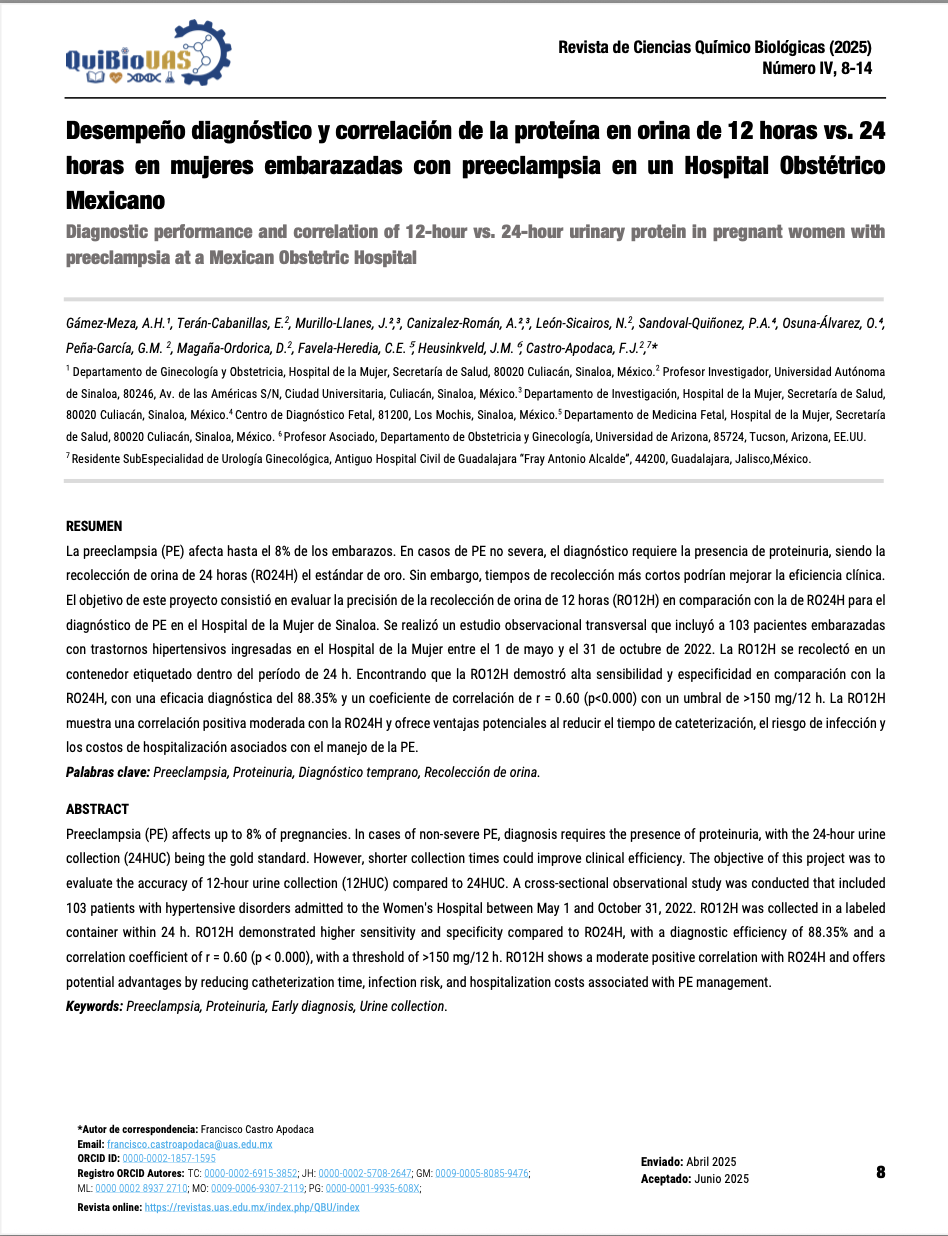Diagnostic performance and correlation of 12-hour vs. 24-hour urinary protein in pregnant women with preeclampsia at a Mexican Obstetric Hospital
Keywords:
Preeclampsia, Proteinuria, Early diagnosis, Urine collectionAbstract
Preeclampsia (PE) affects up to 8 % of pregnancies. In cases of non-severe PE, diagnosis requires the presence of proteinuria, with the 24-hour urine collection (RO24H) being the gold standard. However, shorter collection times could improve clinical efficiency. The objective of this project was to evaluate the accuracy of 12-hour urine collection (12HUR) compared to 24-hour urine collection (24HUR). A cross-sectional observational study was conducted that included 103 patients with hypertensive disorders admitted to the Women's Hospital between May 1 and October 31, 2022. RO12H was collected in a labeled container within 24 hours. RO12H demonstrated higher sensitivity and specificity compared to RO24H, with a diagnostic efficiency of 88.35% and a correlation coefficient of r = 0.60 (p < 0.000), with a threshold of >150 mg/12 hours. RO12H shows a moderate positive correlation with RO24H and offers potential advantages by reducing catheterization time, infection risk, and hospitalization costs associated with PE management.
Downloads
References
American College of Obstetricians and Gynecologists. (2020). Gestational hypertension and preeclampsia: ACOG practice
bulletin, number 222. Obstet Gynecol, 135(6), e237-e260. https://doi.org/10.1097/AOG.0000000000003891
Côté, A. M., Firoz, T., Mattman, A., Lam, E. M., von Dadelszen, P., & Magee, L. A. (2008). The 24-hour urine collection: gold standard or historical practice?. American journal of obstetrics and gynecology, 199(6), 625-e1. https://doi.org/10.1016/j.ajog.2008.06.009
Cresswell, J. A., Alexander, M., Chong, M. Y. C., Link, H. M., Pejchinovska, M., Gazeley, U., Ahmed, S. M. A., Chou, D., Moller, A.-B., Simpson, D., Alkema, L., Villanueva, G., Sguassero, Y., Tunçalp, Ö., Long, Q., Xiao, S., & Say, L. (2025). Global and regional causes of maternal deaths 2009–20: a WHO systematic analysis. The Lancet Global Health, 13(4), e626–e634. https://doi.org/10.1016/S2214-109X(24)00560-6
Lai, J., Syngelaki, A., Nicolaides, K. H., von Dadelszen, P., & Magee, L. A. (2021). Impact of new definitions of preeclampsia at term on identification of adverse maternal and perinatal outcomes. American journal of obstetrics and gynecology, 224(5), 518-e1. https://doi.org/10.1016/j.ajog.2020.11.004
Magee, L. A., Nicolaides, K.H., & Von Dadelszen, P. (2022). Preeclampsia. The New England Journal of Medicine, 386 (19), 1817-1832. https://doi.org/10.1056/nejmra2109523.
Rao, S., Somalwar, S., Bhalerao, A., Raman, V., Rao Jr, S., & Raman Jr, V. (2023). Accuracy of Spot Urine Albumin Creatinine Ratio With Respect to 24-Hour Urine Albumin for the Detection of Proteinuria in Antenatal Women With Preeclampsia: A Descriptive Study. Cureus, 15(6).
http://doi:10.7759/cureus.39961
Restrepo-Moreno, M., Arango-Buitrago, V., Gil-Pabón, C. J., Campo-Campo, M. N., García- Posada, R. A., Gutiérrez-Marín, J. H., Sanín-Blair, J. E., & Echavarría-Restrepo, L. G. (2016). Evaluación de las características operativas de la relación proteína / creatinina en orina ocasional para la detección de proteinuria significativa en gestantes con sospecha de preeclampsia. Revista Colombiana de Obstetricia y Ginecología, 67(3), 223. https://doi.org/10.18597/rcog.770
Rinehart, B. K., Terrone, D. A., Larmon, J. E., Perry, K. G., Martin, R. W., & Martin, J. N. (1999). A 12-hour urine collection accurately assesses proteinuria in the hospitalized hypertensive gravida. Journal of Perinatology, 19(8), 556-558.
https://doi.org/10.1038/sj.jp.7200271
Sarnnok, S., & Kitiyodom, S. (2022). Accuracy of 12-hour versus 24-hour Urine Collection for Diagnosis of Preeclampsia. Thai Journal of Obstetrics and Gynaecology, 82-90. https://doi.org/10.14456/tjog.2022.11
Sibai, B. M. (2005). Diagnosis, prevention, and management of eclampsia. Obstetrics & Gynecology. 105(2):402-10. https://doi: 10.1097/01.AOG.0000152351.13671.99.
Silva, R. M., Pereira, S. R., Rego, S., & Clode, N. (2018). Accuracy of 12‐hour urine collection in the diagnosis of pre‐eclampsia. International Journal of Gynecology & Obstetrics, 142(3), 277-282. https://doi.org/10.1002/ijgo.12536
Stout, M. J., Conner, S. N., Colditz, G. A., Macones, G. A., & Tuuli, M. G. (2015). The utility of 12-hour urine collection for the diagnosis of preeclampsia: a systematic review and meta-analysis. Obstetrics & Gynecology, 126(4), 731-736. https://doi.org/10.1097/aog.0000000000001042
Suresh, S., Patel, E., Mueller, A., Morgan, J., Lewandowski, W. L., Verlohren, S., ... & Rana, S. (2023). The additive role of angiogenic markers for women with confirmed preeclampsia. American Journal of Obstetrics and Gynecology, 228(5), 573-e1. http://doi:10.1016/j.ajog.2022.10.044
Vazquez-Alaniz, F., Salas-Pacheco, J. M., Sandoval-Carrillo, A. A., La-llave-Leon, O., & Hernandez, E. M. M. (2019). Lactate dehydrogenase in hypertensive disorders in pregnancy: severity or diagnosis marker. J Hypertens Manag, 5, 040. http://doi:10.23937/2474-3690/1510040
Wright, D., Wright, A., & Nicolaides, K. H. (2020). The competing risk approach for prediction of preeclampsia. American journal of obstetrics and gynecology, 223(1), 12-23. https://doi.org/10.1016/j.ajog.2019.11.1247

Downloads
Published
Data Availability Statement
The data are available from the corresponding author upon request.
Issue
Section
Categories
License
Copyright (c) 2025 QUIBIOUAS, Journal of Biological Chemical Sciences

This work is licensed under a Creative Commons Attribution-NoDerivatives 4.0 International License.


